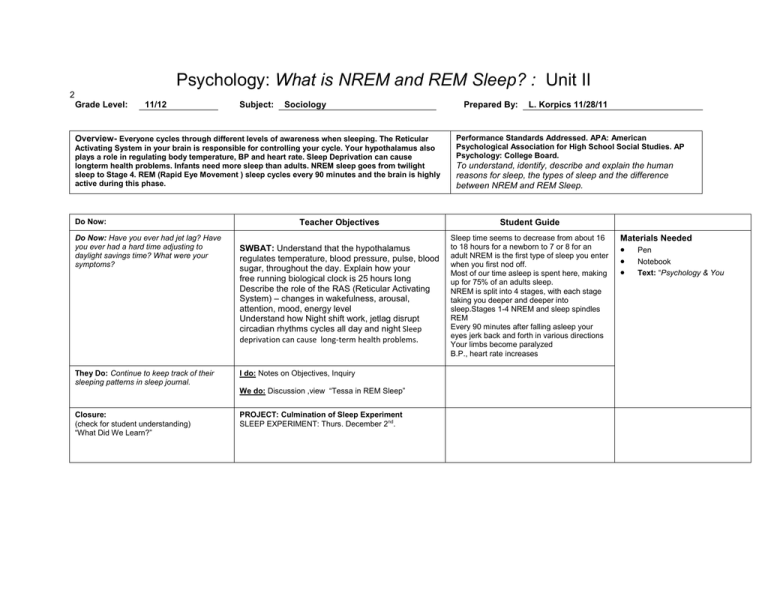LP 27 REM and NREM
advertisement

Psychology: What is NREM and REM Sleep? : Unit II 2 Grade Level: 11/12 Subject: Sociology Overview- Everyone cycles through different levels of awareness when sleeping. The Reticular Activating System in your brain is responsible for controlling your cycle. Your hypothalamus also plays a role in regulating body temperature, BP and heart rate. Sleep Deprivation can cause longterm health problems. Infants need more sleep than adults. NREM sleep goes from twilight sleep to Stage 4. REM (Rapid Eye Movement ) sleep cycles every 90 minutes and the brain is highly active during this phase. Do Now: Do Now: Have you ever had jet lag? Have you ever had a hard time adjusting to daylight savings time? What were your symptoms? They Do: Continue to keep track of their sleeping patterns in sleep journal. L. Korpics 11/28/11 Performance Standards Addressed. APA: American Psychological Association for High School Social Studies. AP Psychology: College Board. To understand, identify, describe and explain the human reasons for sleep, the types of sleep and the difference between NREM and REM Sleep. Teacher Objectives Student Guide SWBAT: Understand that the hypothalamus regulates temperature, blood pressure, pulse, blood sugar, throughout the day. Explain how your free running biological clock is 25 hours long Describe the role of the RAS (Reticular Activating System) – changes in wakefulness, arousal, attention, mood, energy level Understand how Night shift work, jetlag disrupt circadian rhythms cycles all day and night Sleep deprivation can cause long-term health problems. Sleep time seems to decrease from about 16 to 18 hours for a newborn to 7 or 8 for an adult NREM is the first type of sleep you enter when you first nod off. Most of our time asleep is spent here, making up for 75% of an adults sleep. NREM is split into 4 stages, with each stage taking you deeper and deeper into sleep.Stages 1-4 NREM and sleep spindles REM Every 90 minutes after falling asleep your eyes jerk back and forth in various directions Your limbs become paralyzed B.P., heart rate increases I do: Notes on Objectives, Inquiry We do: Discussion ,view “Tessa in REM Sleep” Closure: (check for student understanding) “What Did We Learn?” Prepared By: PROJECT: Culmination of Sleep Experiment SLEEP EXPERIMENT: Thurs. December 2nd. Materials Needed Pen Notebook Text: “Psychology & You





